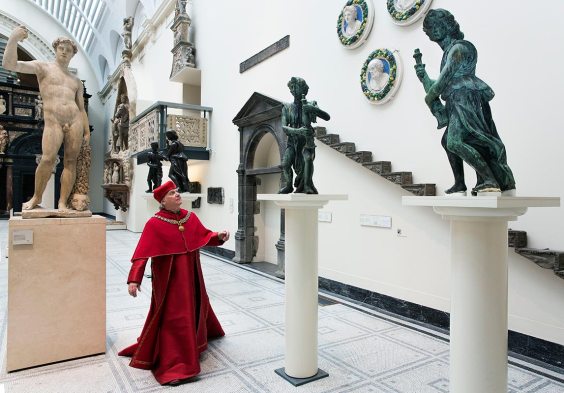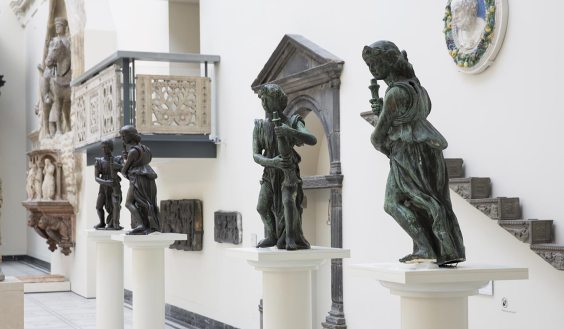The sight of Cardinal Wolsey, gliding between four bronze angels once intended to crown his tomb, was an eerie one. Paul Jesson, who plays the Cardinal in the RSC’s production of Wolf Hall, was in the V&A’s Medieval and Renaissance Galleries to launch a fund-raising campaign to acquire these important objects. At moments like this, it becomes easier to roll back the centuries, and place these Renaissance sculptures into their historic context.

Wolsey Angels fundraising campaign, actor Paul Jesson as Cardinal Wolsey with reunited four bronze angels © Victoria and Albert Museum, London
The angels embody one of the most tumultuous and colourful periods in English history, having once been owned by two of the most powerful men of the Tudor era. Their survival is remarkable. As Hilary Mantel says, ‘the recovery of Wolsey’s angels is one of those miracles that historians pray for; something that seems irrevocably lost has been there all the time.’
The angels were commissioned in 1524 from Benedetto da Rovezzano, a Florentine sculptor and contemporary of Michelangelo, who was working in England under the patronage of Cardinal Thomas Wolsey. They were to form part of Wolsey’s lavish Renaissance style tomb, which he intended to reflect his wealth, taste and statesmanship. However, Wolsey’s failure to persuade the Pope to annul Henry VIII’s first marriage to Catherine of Aragon led to the demise of his career. He died in 1530, with the grandiose tomb still incomplete. Henry promptly seized the completed parts of the tomb for himself, employing Benedetto to create his own royal tomb on an even grander scale. Ironically, Henry did not live to see his tomb finished either, and in 1565 the parts were moved to St George’s Chapel in Windsor where they languished until the Civil War, when they were sold off. Only the black stone chest remained, and was later used for Nelson’s tomb in St Paul’s.

Wolsey Angels on display at the V&A © Victoria and Albert Museum, London
The angels’ more recent history is fascinating. Two of them appeared, unidentified, at an auction in 1994, with nothing known of their original provenance. These angels were eventually identified by art historian Francesco Caglioti. Following this, the other two resurfaced at Harrowden Hall in Wellingborough where it came to light that all four sculptures had once stood on the gateposts.
The V&A aims to raise the £5 million purchase price to acquire the four angels, re-uniting them for the public to enjoy. The National Heritage Memorial Fund and the Art Fund have already lent their support to the appeal and the angels are on display at the V&A for the duration of the campaign.
Donations can be made via the V&A website or by texting VAWA14 £5 to 70070.

Wolsey’s Angels: the V&A seeks to acquire four important Renaissance sculptures
Wolsey Angels on display at the V&A © Victoria and Albert Museum, London
Share
The sight of Cardinal Wolsey, gliding between four bronze angels once intended to crown his tomb, was an eerie one. Paul Jesson, who plays the Cardinal in the RSC’s production of Wolf Hall, was in the V&A’s Medieval and Renaissance Galleries to launch a fund-raising campaign to acquire these important objects. At moments like this, it becomes easier to roll back the centuries, and place these Renaissance sculptures into their historic context.
Wolsey Angels fundraising campaign, actor Paul Jesson as Cardinal Wolsey with reunited four bronze angels © Victoria and Albert Museum, London
The angels embody one of the most tumultuous and colourful periods in English history, having once been owned by two of the most powerful men of the Tudor era. Their survival is remarkable. As Hilary Mantel says, ‘the recovery of Wolsey’s angels is one of those miracles that historians pray for; something that seems irrevocably lost has been there all the time.’
The angels were commissioned in 1524 from Benedetto da Rovezzano, a Florentine sculptor and contemporary of Michelangelo, who was working in England under the patronage of Cardinal Thomas Wolsey. They were to form part of Wolsey’s lavish Renaissance style tomb, which he intended to reflect his wealth, taste and statesmanship. However, Wolsey’s failure to persuade the Pope to annul Henry VIII’s first marriage to Catherine of Aragon led to the demise of his career. He died in 1530, with the grandiose tomb still incomplete. Henry promptly seized the completed parts of the tomb for himself, employing Benedetto to create his own royal tomb on an even grander scale. Ironically, Henry did not live to see his tomb finished either, and in 1565 the parts were moved to St George’s Chapel in Windsor where they languished until the Civil War, when they were sold off. Only the black stone chest remained, and was later used for Nelson’s tomb in St Paul’s.
Wolsey Angels on display at the V&A © Victoria and Albert Museum, London
The angels’ more recent history is fascinating. Two of them appeared, unidentified, at an auction in 1994, with nothing known of their original provenance. These angels were eventually identified by art historian Francesco Caglioti. Following this, the other two resurfaced at Harrowden Hall in Wellingborough where it came to light that all four sculptures had once stood on the gateposts.
The V&A aims to raise the £5 million purchase price to acquire the four angels, re-uniting them for the public to enjoy. The National Heritage Memorial Fund and the Art Fund have already lent their support to the appeal and the angels are on display at the V&A for the duration of the campaign.
Donations can be made via the V&A website or by texting VAWA14 £5 to 70070.
Unlimited access from just $16 every 3 months
Subscribe to get unlimited and exclusive access to the top art stories, interviews and exhibition reviews.
Share
Recommended for you
Culture Minister Aurélie Filippetti leaves the French Cabinet
Filippetti left the Cabinet in the midst of a political crisis which resulted in a reshuffle this weekend
First Look: ‘Sympathy for the Devil’ at the Cantor Arts Center
A new exhibition at Stanford University looks at the changing face of the devil in art
Review: ‘The Art and Science of Exploration’ at the Queen’s House
A new display of art from Captain Cook’s voyages is compelling, but doesn’t quite tell the whole story